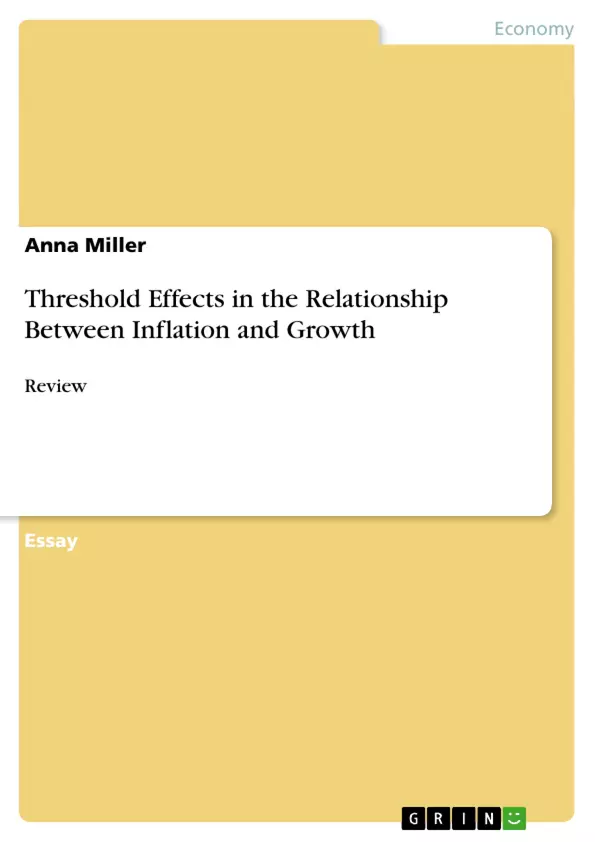Up to the 1970s it was mostly observed that inflation does not have a significant effect on growth, or that the effect was even slightly positive (Sarel 1996). However, due to the following decades of high and persistent inflation in many countries1, the available data showed changes in the inflation-growth nexus. It was univocally confirmed that inflation has a negative impact on growth, and macroeconomic policies are aiming to spur growth by keeping inflation at low levels. This having said, intuitively the question arises, how low should the target inflation be? Or, which is the threshold level of inflation between a positive and negative impact on growth? Many authors in the 1990s attempted to solve this question, with fairly divers results. Sarel (1996) analysed a panel of 87 countries over the period 1970 to 1990 using OLS estimation. He finds a structural break at an average annual rate of inflation of 8%. Below this level, inflation has no significant effect on growth, but for inflation levels above 8%, growth is significantly and strongly negatively affected. Gosh and Phillips (1998) find a much lower threshold at 2.5%, and Christoffersen and Doyle (1998), applying Sarel’s methodology on transient countries between 1990-1996, obtain a threshold of 13%. Bruno and Easterly’s (1998) results are somewhat striking. Their analysis is based on a sample of 31 countries that experienced high-inflation episodes over the period 1961-1994, and results in the fact that inflation does not have a significant effect on growth for normal levels, however the relationship becomes negative with high-frequency data and highinflation observations of 40% or higher.Motivated by this variety of results, Khan and Senhadji re-examined this issue in their 2001 paper “Threshold Effects in the Relationship Between Inflation and Growth”. They contribute to existing work by extending and modifying their analysis compared to previous literature by, first, looking separately on developing and industrialized countries, and second, by applying new econometric methods, which include the non-linear least squares (NLLS) estimation combined with a hybrid function of inflation, where the threshold level is found with conditional least squares. Furthermore, Khan and Senhadji (2001) use the bootstrap method, proposed by Hansen (1999), in order to test for statistical significance of the threshold effect. Accordingly, their results differ in so far from previous work as the threshold...
Inhaltsverzeichnis (Table of Contents)
- Motivation
- Model and Discussion
Zielsetzung und Themenschwerpunkte (Objectives and Key Themes)
This paper aims to re-examine the relationship between inflation and economic growth, particularly focusing on the existence of threshold effects. The authors extend previous research by examining developing and industrialized countries separately and employing new econometric methods.
- The impact of inflation on economic growth.
- The existence and estimation of threshold levels for inflation.
- Comparison of different econometric methods for analyzing the inflation-growth relationship.
- The role of data frequency and country-specific characteristics in determining threshold levels.
- The robustness of findings to different data specifications and econometric approaches.
Zusammenfassung der Kapitel (Chapter Summaries)
Motivation
This section reviews previous studies on the inflation-growth relationship, highlighting conflicting findings regarding the threshold level of inflation. The authors present a rationale for their research, motivated by the need to clarify the complex relationship between inflation and growth, particularly in the context of developing and industrialized economies.
Model and Discussion
This section presents the econometric model used by Khan and Senhadji (2001) to analyze the threshold effects in the inflation-growth relationship. The authors discuss the advantages of their approach, which involves utilizing a hybrid inflation function, non-linear least squares estimation, and a conditional least squares technique to determine the threshold level. The section also addresses criticisms raised against the model, emphasizing the importance of data frequency and country-specific characteristics in understanding the relationship between inflation and growth.
Schlüsselwörter (Keywords)
The paper focuses on the relationship between inflation and economic growth, specifically examining the existence of threshold effects. It uses advanced econometric methods, such as non-linear least squares (NLLS) and conditional least squares, to estimate threshold levels for different types of countries. The paper also discusses the role of data frequency and country-specific characteristics in shaping the inflation-growth relationship.
- Quote paper
- Anna Miller (Author), 2013, Threshold Effects in the Relationship Between Inflation and Growth, Munich, GRIN Verlag, https://www.grin.com/document/263451



